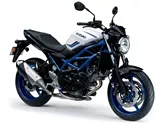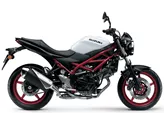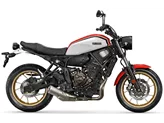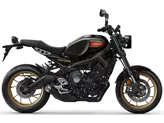Suzuki SV 650 2023 vs. Yamaha XSR900 2018
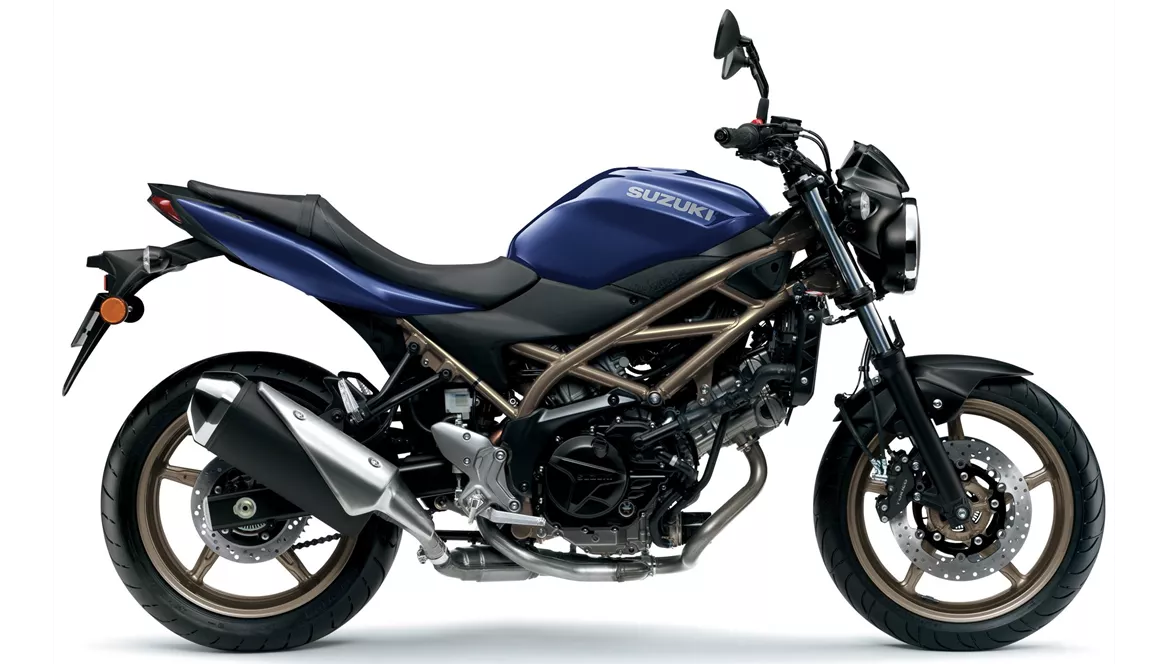
Suzuki SV 650 2023

Yamaha XSR900 2018
Overview - Suzuki SV 650 2023 vs Yamaha XSR900 2018
In terms of engine and drive train, the Suzuki SV 650 2023 is equipped with a V2 engine that produces 73 HP of power and 64 Nm of torque. On the other hand, the Yamaha XSR900 2018 features an in-line engine that delivers a higher power output of 115 HP and torque of 87.5 Nm. The Suzuki SV 650 has 2 cylinders, while the Yamaha XSR900 has 3 cylinders. Both bikes have liquid cooling systems and similar displacements, with the Suzuki at 645 ccm and the Yamaha at 847 ccm.
In terms of suspension, both bikes have a swing arm and a monoshock rear suspension. However, the Suzuki SV 650 has a telescopic fork front suspension, while the Yamaha XSR900 has an upside-down telescopic fork front suspension.
In terms of chassis, the Suzuki SV 650 has a steel frame, while the Yamaha XSR900 has an aluminum frame. The frame type of the Suzuki is tubular, while the Yamaha has a twin tube frame.

Suzuki SV 650 2023
Both bikes have double disk front brakes, with the Suzuki having a diameter of 290 mm and the Yamaha having a slightly larger diameter of 298 mm. Both bikes also have ABS as an advanced rider assistance system.
In terms of dimensions and weights, both bikes have a front tire width of 120 mm and a front tire diameter of 17 inches. The Suzuki has a rear tire width of 160 mm and a rear tire diameter of 17 inches, while the Yamaha has a wider rear tire width of 180 mm. The wheelbase of both bikes is similar, with the Suzuki at 1445 mm and the Yamaha at 1440 mm. The seat height of the Suzuki is 785 mm, while the Yamaha has a slightly higher seat height of 815 mm. The kerb weight of the Suzuki with ABS is 200 kg, while the Yamaha weighs slightly less at 191 kg. Both bikes have fuel tank capacities of around 14 liters.
Now, let's discuss the strengths and weaknesses of each bike. The Suzuki SV 650 2023 is praised for having the last V2 powerplant in its class, which provides a unique and distinctive engine configuration. It also has a beginner-friendly seating position and easy handling, making it suitable for riders of all levels. Additionally, the timeless look of the Suzuki SV 650 adds to its appeal.
On the other hand, the Yamaha XSR900 2018 is known for its extremely sporty and rev-happy engine, which offers a thrilling riding experience. It also boasts excellent brakes, providing strong stopping power. The Yamaha XSR900 offers a pleasant seating position and high-quality workmanship. Furthermore, it is considered to have a good price-performance ratio.

Yamaha XSR900 2018
However, the Suzuki SV 650 does have some weaknesses. The brake requires manual force, which may not be as convenient for some riders. Additionally, the bike lacks electronic features apart from ABS, and the readability of the instruments is only moderate.
Similarly, the Yamaha XSR900 has a few weaknesses. Some riders find the response of the bike to be almost too direct, which may require more skill to handle. Additionally, while the retro style of the Yamaha XSR900 is appreciated, it is noted that it may not have been thought through to the last detail.
In conclusion, the Suzuki SV 650 2023 and the Yamaha XSR900 2018 are both capable naked bikes with their own strengths and weaknesses. The Suzuki offers a V2 powerplant and beginner-friendly features, while the Yamaha provides a more sporty engine and high-quality craftsmanship. Ultimately, the choice between the two will depend on the rider's preferences and priorities.
Technical Specifications Suzuki SV 650 2023 compared to Yamaha XSR900 2018
Pros and Cons in comparison
Pros and Cons in comparison
Suzuki SV 650 2023

The Suzuki SV 650 has been on the market for 25 years, longer than any other motorbike. The engine has been updated to Euro5 and is now even more mature, which clearly fits in with the rest of the package. The SV 650 doesn't want to scare anyone, especially beginners. The chassis makes a solid, unagitated impression, the brakes require a lot of manual force to prevent unexpected overbraking. The look is timeless on the one hand, but on the other hand some components are really a bit outdated. On the other hand, the price is fair, as usual for Suzuki.
Yamaha XSR900 2018

The Yamaha XSR900 is a classic optical illusion - with its round headlight, angular tank and attached tail light, it clearly passes for a retro bike. But it's no coincidence that the performance is reminiscent of the potent mid-range naked bike Yamaha MT-09, which is the extremely sporty basis for the XSR900. So the engine is a blast and the brakes are appropriately venomous. Fortunately, the engineers didn't overdo it with the chassis, the XSR900 offers sufficient comfort and the upright riding position is more comfortable than the powerful engine would lead one to expect. All in all, the XSR900 is one of the sportiest models among the retro bikes.
Price Comparison Avarage Market Price Suzuki SV 650 vs Yamaha XSR900
There are a few key differences between a Suzuki SV 650 2023 and a Yamaha XSR900 2018. In terms of price, the actual average price of a Yamaha XSR900 2018 is about 24% higher. Compared to Yamaha XSR900 2018 there are more Suzuki SV 650 2023 bikes available on the 1000PS.de Marketplace, specifically 125 compared to 4. It takes less time to sell a Yamaha XSR900 with 123 days compared to 133 days for the Suzuki SV 650. Since model year 2005 1000PS.de editors have written 25 reviews for the Suzuki SV 650 and 30 reviews for the Yamaha XSR900 since model year 2016. The first review for the Suzuki SV 650 was published on 9/26/2008 and now has more than 14,200 views. This compares to more than 17,600 views for the first review on Yamaha XSR900 published on 11/25/2015.












